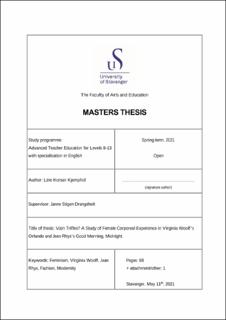| dc.description.abstract | “To be modern is to live a life of paradox and contradiction” (13) writes Marshall Berman in an attempt to grasp the vast history of modernity. This thesis will be an investigation of what this life of paradox and contradiction involves in terms of women’s corporeal experience in the early 20th century, and how this is represented in two works of modernist fiction. The novels which will be investigated are Orlando (1928) by Virginia Woolf and Good Morning, Midnight (1939) by Jean Rhys. The novels are connected in the sense that they are both written by female authors and provide a female perspective on the physical experience of being a woman in modernity.
Modernity involved radical transformations for women in many ways, because, historically, women were confined to the domestic sphere. In the late 19th century, however, the “New Woman” emerged as a feminist ideal, and soon women were given the opportunity to move, and even work, in the public sphere. In the large and expanding cities, women could enjoy a newfound freedom and a financial independence that they had previously been denied. Even so, it seems that the city was still a hostile place for the public woman, much because of the threat she posed to the order of patriarchal society. Both of the works in question represent the gendered manifestations of the human being in a social and cultural setting, and probe some of the challenges that the public woman emblemises.
This thesis will particularly investigate to what degree clothing defined the “New Woman”. As will be argued, clothing can be seen as an important tool for liberation because the new fashion relieved women of the heavy and restrictive garments that previously almost did not enable them to move. However, both novels engage with sartorial play in order to demonstrate how the performative features of clothes still function to restrict women. It seems that women are to a large extent imprisoned by the very tools that were meant to liberate them. | |
